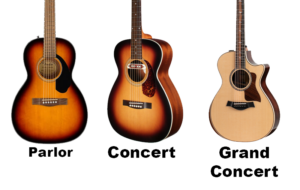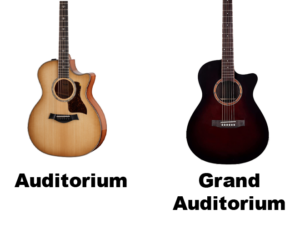Uncategorized
Unlocking the Musical Doorway: Exploring Guitar Keys
Hello, fellow music explorers and curious minds! Have you ever wondered about the magical world of guitar keys and how they shape the melodies we love? Today, we’re embarking on a melodious journey that unravels the mysteries of guitar keys – the secret codes that open doors to harmonies, emotions, and musical expression. Whether you’re a budding guitarist eager to understand the foundations of music or a music enthusiast intrigued by the enchanting sounds of the guitar, this guide will introduce you to the captivating universe of “Guitar Keys.” So, sit back, relax, and let’s embark on a harmonic adventure that will illuminate the way melodies come to life!
Understanding Guitar Keys: The Musical Palette
Imagine a key as a palette of colors that an artist uses to paint a masterpiece. In the realm of music, guitar keys are similar – they provide a set of notes that create a distinct tonal center for a song. Each key has its unique mood, character, and emotional resonance, much like different colors evoke varied feelings in a painting. Just as artists choose their colors intentionally, musicians select guitar keys purposefully to evoke emotions and tell musical stories.
The Basics of Guitar Keys: Major and Minor
Guitar keys come in two primary flavors: major and minor. The major key evokes a bright, uplifting, and joyful feeling, while the minor key carries a more somber, introspective, and melancholic quality. Imagine a major key as a sunny day, and a minor key as a moonlit night – both beautiful, yet conveying distinct emotions.
Key Signatures and Chords: The Building Blocks
A key signature is like a musical roadmap, indicating which notes are natural, sharp, or flat within a particular key. Each key has its unique combination of notes, forming a pattern that dictates the chords and melodies that fit harmoniously within it. For example, the key of C major consists of the notes C, D, E, F, G, A, and B. These notes serve as the building blocks for chords and melodies that create a cohesive musical experience.
Transposing: Shifting the Musical Landscape
Imagine taking a piece of art and placing it in a different frame – transposing is a bit like that for music. Transposing involves moving a song or a melody from one key to another. This can alter the mood and character of the music while maintaining the same structural relationships between the notes. Transposing allows musicians to adapt a piece to suit their vocal range, instrument, or artistic interpretation.
Modulation: Changing the Musical Direction
Modulation is like a musical journey from one key to another. It involves smoothly transitioning from one key to a related key, often to create a sense of progression or development in a composition. Modulation can evoke emotions ranging from anticipation to resolution, adding depth and complexity to a musical piece.
Guitar Keys in Action: Musical Examples
Let’s explore a couple of musical examples to illustrate the impact of guitar keys:
1. “Happy” by Pharrell Williams: This upbeat song is in the key of F major, which contributes to its joyful and celebratory vibe.
2. “Eleanor Rigby” by The Beatles: The melancholic atmosphere of this classic is attributed to its key of E minor, enhancing its introspective and emotional lyrics.
Conclusion: Embrace the Harmonic Adventure
Congratulations, you’ve embarked on a harmonious adventure through the captivating realm of guitar keys. As you explore major and minor tonalities, key signatures, and the art of transposing, you’ll gain a deeper appreciation for the role keys play in shaping the melodies and emotions that resonate within us. Whether you’re strumming chords on an acoustic guitar or shredding solos on an electric, the world of “Guitar Keys” offers a treasure trove of possibilities waiting to be unlocked. So, the next time you hear a song that moves your soul, remember that it’s the result of a careful selection of notes and chords – a musical key that opens the door to a world of harmonies, emotions, and infinite creativity.
Uncategorized
Acoustic Guitar Sizes: Finding Your Perfect Fit
Have you ever wondered how the size of an acoustic guitar affects its sound? From the intimate, focused tones of a parlor guitar to the deep, resonant sound of a jumbo, the size and shape of an acoustic guitar can have a profound impact on its sonic characteristics.”
In this article, we’ll explore acoustic guitar sizes, their variations, and how to choose the perfect size that suits your needs.
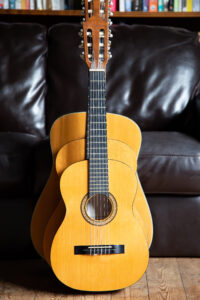 Understanding Acoustic Guitar Sizes: A Musical Puzzle
Understanding Acoustic Guitar Sizes: A Musical Puzzle
Acoustic guitar sizes refer to the dimensions and proportions of the guitar body, which significantly influence the instrument’s tonal characteristics, projection, and playability.
Just like pieces of a musical puzzle, different sizes create distinct voices that cater to various playing styles and preferences.
The Spectrum of Acoustic Guitar Sizes
Acoustic guitars come in several sizes, each with its unique qualities and attributes. Let’s explore some common acoustic guitar sizes and their defining features:
-
-
Parlor Guitar: The parlor guitar is petite and charming, making it an ideal companion for intimate settings.
The name comes from the rooms in which the guitar was typically played in the late 19th century.
Some famous musicians who have been known to use the parlor guitar are, Eric Clapton, Mark Orton, Ed Sheehan, and John Mayer
Its smaller size results in a focused and balanced sound, perfect for fingerpicking and folk music.
-
Concert Guitar: Slightly larger than the parlor guitar, the concert guitar offers enhanced projection and volume. It strikes a balance between portability and sound, making it versatile for various genres.
It is often used in classical music and flamenco music with its full sound.
-
Grand Concert Guitar: With a larger body than the concert guitar, the grand concert guitar boasts a fuller sound and improved tonal complexity.
A popular choice for those who have a smaller stature and require an instrument that’s built to a shorter scale. Great choice for traveling musicians who often play live performances.
It’s suitable for fingerstyle playing and intricate arrangements.
-
Auditorium Guitar: The auditorium guitar, also known as the orchestra model (OM), features a well-rounded sound with a pronounced midrange.
More shallower than the dreadnought and narrower in width than a concert guitar. An Auditorium guitar brings the body closer to the player, making it feel more intimate and comfortable for stage use.
Some famous musicians who play it include Ed Sheeran, John Mayer, and Eric Clapton.
-
Grand Auditorium Guitar: Expanding on the auditorium guitar’s design, the grand auditorium guitar offers a versatile sound profile with enhanced bass response and overall volume.
It is a versatile mid-sized guitar that is a good choice for those who want a single guitar to travel with. The tone is great for strumming and picking. It performs well on stage and in the studio.
It suits a wide range of musical genres.
-
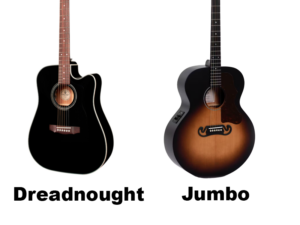 Dreadnought Guitar: The Dreadnought is a true icon, known for its bold and powerful sound. Its large body produces a strong bass response, making it ideal for strumming and vocal accompaniment.
Dreadnought Guitar: The Dreadnought is a true icon, known for its bold and powerful sound. Its large body produces a strong bass response, making it ideal for strumming and vocal accompaniment.This guitar is known for its powerful voice and lower-mid-rich tones that make it a favored choice for country artists. Although it is a popular choice for musicians of all genres.
Some famous musicians who play the dreadnought guitar include Hank Williams Jr, Elvis Presley, Keith Richards, Thom Yorke, and Kurt Cobain.
The original dreadnought guitars were made for the Oliver Ditson Company and featured mahogany backs and sides and spruce tops.
-
Jumbo Guitar: The jumbo guitar lives up to its name with a massive body that delivers robust volume and a deep bass presence.
This is the largest of the guitar family with a deeper body than the popular dreadnought. The body is wider and deeper than traditional acoustic guitars, which gives them a unique appearance.
Jumbo’s are well suited to rhythm guitarists in country and folk rock, and produce a deep rich sound favored by heavy strummers. Some famous musicians who play this guitar are Elvis Presley, George Harrison of the Beatles, Neil Young, Sheryl Crow, and Pete Townshend of The Who.
Choosing the Right Acoustic Guitar Size for You
Selecting the right acoustic guitar size involves considering factors such as playing style, comfort, and tonal preferences. Here are some steps to guide you on your quest:
-
Identify Your Playing Style: Determine whether you lean towards fingerpicking, strumming, or a mix of both. Different sizes excel in different playing styles, so choose one that complements your technique.
-
Consider Body Comfort: Hold and play guitars of various sizes to assess comfort. A guitar that fits well against your body ensures a pleasant playing experience, especially during extended sessions.
-
Evaluate Sound Preferences: Listen to the sound produced by different acoustic guitar sizes. Pay attention to tonal qualities, such as warmth, brightness, and projection, to find the one that resonates with your musical taste.
The Influence of Acoustic Guitar Sizes on Music
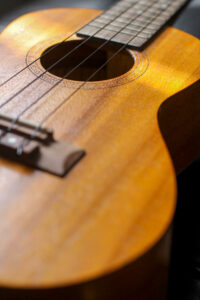 Acoustic guitar sizes and shapes can have a significant impact on the sound of the instrument.
Acoustic guitar sizes and shapes can have a significant impact on the sound of the instrument.The size of the guitar body type also relates to the volume of air within the instrument. Changes to the air capacity of the body will emphasize specific frequencies. A smaller body will have a more focused sound centered on higher frequencies, while a larger body will produce deeper low-end frequencies.
Body dimensions can provide some indication of the tone you might expect, but other factors exert a profound influence, too. Much depends on the tonewoods used to construct the body and the shape, size, and layout of the braces.
Finding Harmony in Acoustic Guitar Sizes
By delving into the nuances of size, sound, and playability, you’ve gained insights that will guide you toward the perfect fit for your musical aspirations.
As you continue your exploration, remember that each acoustic guitar size has its own unique voice and character. Embrace the joy of trying different sizes, celebrate the nuances of their sounds, and let your heart lead you to the one that resonates with your musical soul.
-
Uncategorized
Exploring the Melodic Universe of Jazz Scales: Your Gateway to Musical Elegance
Hello, music enthusiasts and curious minds! Are you ready to embark on a harmonious journey that unveils the enchanting world of jazz scales? Today, we’re delving into the captivating realm of jazz scales – a collection of musical notes that form the foundation of jazz improvisation and expression. Whether you’re a budding musician eager to explore new horizons or a curious listener seeking to unravel the magic of jazz, this guide will introduce you to the mesmerizing universe of “Jazz Scales.” So, sit back, relax, and let’s dive into the melodious tapestry of musical creativity and sophistication!
Understanding Jazz Scales: The Essence of Improvisation
Think of jazz scales as a palette of colors that jazz musicians use to paint intricate and expressive musical pictures. These scales serve as the raw materials for jazz improvisation, allowing musicians to create spontaneous and captivating melodies. Just as a chef combines various ingredients to craft a delicious dish, jazz musicians blend different notes to concoct harmonious and soul-stirring musical tales.
The Versatility of Jazz Scales: A Palette of Melodic Choices
Jazz scales come in a variety of flavors, each with its distinct character and mood. Let’s explore some popular jazz scales:
1. Major Scale: The cornerstone of Western music, the major scale offers a bright and cheerful sound, making it a versatile choice for jazz improvisation.
2. Dorian Scale: With a hint of minor melancholy and a touch of jazz flair, the Dorian scale is a favorite among jazz musicians for its expressive potential.
3. Mixolydian Scale: This scale infuses a bluesy and soulful essence into jazz melodies, adding a layer of depth and emotion.
4. Lydian Scale: Known for its dreamy and ethereal quality, the Lydian scale adds a sense of intrigue and mystery to jazz improvisation.
Mastering Jazz Scales: A Journey of Musical Discovery
Now, let’s unravel the mechanics of mastering jazz scales:
1. Learn the Patterns: Jazz scales follow specific patterns of whole and half steps. By understanding these patterns, you can navigate the scales effortlessly.
2. Ear Training: Train your ears to recognize the unique sounds of each scale. This skill will help you instinctively choose the right scale for a given musical context.
3. Practice with Backing Tracks: Play along with jazz backing tracks to immerse yourself in the world of improvisation. Experiment with different scales and explore your creativity.
4. Transcribe Jazz Solos: Analyze and transcribe solos from jazz legends. This practice will deepen your understanding of how scales are used in improvisation.
Jazz Scales in Action: Musical Examples
Jazz scales breathe life into captivating melodies and solos. Here are a few famous jazz standards that showcase the allure of jazz scales:
1. “Autumn Leaves”: This timeless tune often employs the Dorian scale, creating a warm and nostalgic atmosphere.
2. “All the Things You Are”: The song’s intricate chord progressions make it a playground for various jazz scales, allowing musicians to weave complex and enchanting solos.
Tips for Exploring Jazz Scales
As you embark on your journey to explore jazz scales, consider these tips to enhance your musical experience:
1. Start Slow: Begin with one or two scales and gradually expand your repertoire as you become more comfortable.
2. Experiment with Rhythms: Alter your rhythm patterns while improvising to add rhythmic interest to your solos.
3. Play with Feel: Focus on expressing emotions through your playing. Let the scales serve as a means to convey your musical ideas.
Conclusion: Your Jazz Odyssey with Jazz Scales
Congratulations, you’ve embarked on a melodious journey through the captivating universe of jazz scales. As you learn, practice, and experiment, you’ll discover the power of these scales to elevate your musical expression and improvisation skills. Keep exploring, keep experimenting, and keep embracing the enchanting allure of jazz scales. They are your key to a world of musical creativity, where each note becomes a brushstroke on the canvas of sound. So, keep playing, keep grooving, and let the mesmerizing world of jazz scales lead you toward a realm of melodies that stir the soul and ignite the imagination, one soulful note at a time!
Uncategorized
Exploring the Vast Universe of Guitar Chords: How Many Guitar Chords Are There?
In the world of music, the guitar stands as a versatile and captivating instrument, capable of producing a rich tapestry of melodies and harmonies. At the heart of this sonic landscape lie chords—a collection of notes that, when played together, create the foundation of countless songs and compositions. But just how many guitar chords are there? The answer to this question unveils a fascinating journey through the realm of musical possibilities. Whether you’re a beginner strumming your first chords or an experienced player seeking to expand your harmonic horizons, this article will take you on a melodious exploration of the multitude of guitar chords that await your discovery.
A World of Harmony and Variation
The guitar’s six strings and fretboard layout provide an expansive canvas for chord creation. When you consider different finger positions, voicings, and inversions, the number of potential guitar chords becomes virtually infinite. From the familiar chords like C, G, and D, to the more intricate jazz and extended chords, the possibilities for chord combinations are vast and exciting.
Basic Chords and Beyond
Beginners often start with a set of foundational chords, such as A, E, and F. As you progress, you’ll encounter barre chords that allow you to play the same chord shape in different positions along the fretboard. These variations create a broader tonal palette, enabling you to infuse your playing with depth and complexity.
Exploring Different Voicings
Voicings refer to the specific arrangement of notes within a chord. For instance, the C major chord can be played in various voicings by altering the order of the notes. This variation not only adds a unique flavor to your playing but also opens up opportunities for creative exploration.
The Power of Inversions
Inversions involve changing the order of the notes within a chord, so the lowest note is no longer the root. This technique can create smoother transitions between chords and add a sense of fluidity to your playing. Inversions also enable you to navigate the fretboard more efficiently, especially during chord progressions.
Jazz Chords and Extended Harmonies
For those delving into jazz or advanced music theory, the realm of chords expands even further. Jazz chords often include extended harmonies, such as 7th, 9th, and 13th chords, which add complexity and sophistication to your playing. These chords provide a platform for intricate improvisation and lend a distinct flavor to jazz compositions.
Digital Tools and Chord Libraries
In the age of technology, musicians have access to a treasure trove of digital tools and resources that can aid in chord exploration. Online chord libraries and mobile apps offer chord diagrams, alternate fingerings, and even audio samples, enabling players to experiment with new chord voicings and progressions.
The Joy of Musical Discovery
As you embark on your journey to explore the world of guitar chords, remember that the number of possibilities is boundless. Each new chord you encounter adds another layer to your musical repertoire and enhances your ability to express emotions, tell stories, and connect with your audience.
Practical Application and Creativity
While the theoretical potential for guitar chords may be infinite, the practical application depends on factors such as the genre you’re playing and the specific mood you wish to convey. Experimenting with different chord progressions, voicings, and inversions can lead to unexpected sonic landscapes that set your playing apart and spark your creative instincts.
Conclusion
So, how many guitar chords are there? The answer is both quantifiable and limitless. While you can categorize and count a finite number of chord types, the true magic lies in the infinite variations, voicings, and inversions that can be explored and crafted by the hands of a dedicated guitarist. Whether you’re strumming a simple folk tune or embarking on a jazz odyssey, the guitar chords at your fingertips are an invitation to explore, create, and paint sonic masterpieces that resonate with your unique musical voice.
-
advanced9 years ago
How to Play “Sleepwalk” on the 3-String Guitar! Guitar TABs Included!
-
beginner8 years ago
3-String or 4-String? How to Decide Which is Right for You!
-
beginner9 months ago
Exploring Different Guitar Types: A Beginner’s Guide
-
Blues Guitar8 years ago
Go-To Tunings for Blues Slide Guitar
-
advanced9 months ago
Fun and Effective Guitar Exercises: Elevate Your Playing with These 5 Simple Techniques
-
Blues Guitar7 years ago
Jack Daniel’s Whiskey Barrel Guitar: How It’s Made and What it Sounds Like
-
Uncategorized9 months ago
Acoustic Guitar Sizes: Finding Your Perfect Fit
-
Guitars9 months ago
Bass vs Guitar: Exploring the Musical Journey

